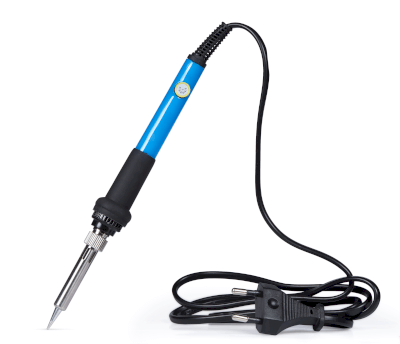What Is a Soldering Iron?

A soldering iron is a tool used for soldering metal-to-metal joints such as the legs of electronic components and the wiring on a circuit board.
It has a simple structure with a plastic handle attached to a metal part that heats and melts the solder. In soldering, an alloy layer is created between the metal to be joined and the solder, where the metal and solder fuse together.
The purpose of the soldering process is primarily to allow electricity to pass through the connected metal parts. Therefore, it is not required to be as strong as welding operations. Solder has a low melting point for a metal, so the soldering iron does not melt the metal of the electronic components and wiring.
Another advantage is that once wiring is done, it can be modified by reheating the solder.
Uses of Soldering Irons
Soldering irons are used for wiring electronic components at manufacturing and production sites and for electrical wiring and repairs in general households. There are two types of soldering irons: ceramic heaters and nichrome heaters.
1. Ceramic Heater
Ceramic heaters consist of a tungsten heater encased in ceramic, which heats the tip from the inside. It takes a short time to reach the proper soldering temperature and has excellent insulation properties, making it suitable for wiring ICs and other delicate electronic components.
2. Nichrome Heater
A nichrome heater is a type of soldering iron that heats from the outside by wrapping a nichrome wire around the tip. Because it is inexpensive, it is suitable for simple electrical wiring and repair work at home or for learning.
Principle of Soldering Irons
When using a soldering iron, first contact the soldering iron tip with a joint point, such as the foot of a device, to heat the metal part so that the Soldering Iron can easily blend with it. At this point, the larger the area of direct contact between the iron tip and the metal part, the more efficient the heat is transferred.
If the tip size is small, heat is not transferred well and work efficiency is reduced. On the other hand, if the tip is larger than the area to be joined, it may damage other areas than the metal part, so care must be taken.
Once the soldering iron has sufficiently warmed up the metal to be joined, press the tip of the soldering iron against the metal while keeping the soldering iron tip on the metal part. The solder will melt immediately and spread over the warmed metal. When the solder is spread over the metal and slightly raised, release the solder, then the Soldering Iron. This step creates an electrical connection between the metal joints.
Soldering Structure
Soldering is a welding process used to wire components within electrical and electronic circuits. The priority is on the performance of the connection when energized rather than on fixing things in place. Soldering uses the phenomena of “wetting” and “capillary action” to weld.
Wettability means, for example, that when a drop of water is dropped on glass and metal, it spreads thinly on the glass and becomes a sphere on the metal. This is because the rate of adhesion to the glass is greater than the cohesive force of water molecules, and this state is called wetting. This state is called wetting. In order for the solder to blend well with the base metal, this wetting must occur in order to weld properly.
The other is capillary action, which is the penetration of liquid into narrow gaps. In soldering, penetration of molten solder into the base metal into the gap is an important factor that determines the finished product.
Other Information about Soldering Irons
1. Difference Between Soldering and Brazing
Soldering is classified as brazing in welding. Similar to soldering is what is called brazing. This is also a welding method classified as brazing. The joining principle is exactly the same, but the performance requirements and tools for the joint are different.
The temperature is classified according to the melting point temperature of the soldering material (solder or brazing material), with brazing being considered being higher than 450°C and soldering lower than 450°C. In actuality, however, the temperature is actually around 450°C. In reality, however, there are few solder materials with melting points in the vicinity of 450°C, and there is no clear reason for this classification.
2. Lead-Free Solder
Traditionally, solder was made of an alloy of lead and tin, but since 2000, environmentally friendly lead-free solder has become the mainstream. Lead-free solder has a higher melting point and lower fluidity than conventional solder, making soldering a hotter and more time-consuming process.
Therefore, when using lead-free solder, a ceramic-heated soldering iron with excellent insulation and thermal conductivity is suitable.